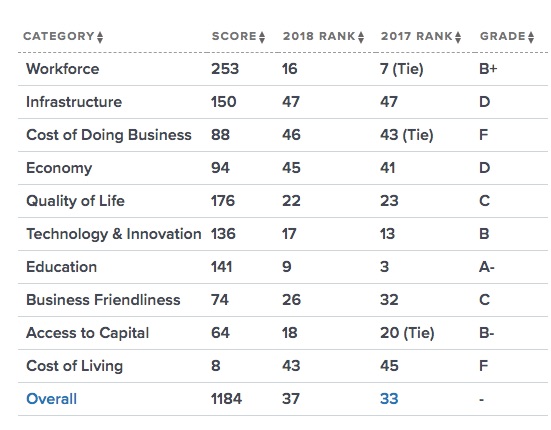Overview
Read on for some statistics and insights about the level of civic engagement, political engagement and a “state of the state” overview of Connecticut.
Civic and Political Engagement
According to the Corporation for National and Community Service for 2018:
- 31.8% of residents volunteer, ranking them 30th among the 50 states and Washington, DC.
- 913,927 volunteers
- 71.5 million hours of service
- $1.7 billion worth of service contributed
Looking at political engagement specifically, according to this 2018 Wallethub.com study, Connecticut ranks #22 based on a weighted average across the following metrics:
- Percentage of Registered Voters in the 2016 Presidential Election
- Percentage of Electorate Who Actually Voted in the 2014 Midterm Elections
- Percentage of Electorate Who Actually Voted in the 2016 Presidential Election
- Change in Percentage of Electorate Who Actually Voted in the 2016 Elections Compared with the 2012 Elections
- Total Political Contributions per Adult Population
- Civic Education Engagement, CIRCLE
- Voter Accessibility Policies, Ballotpedia
Sources: Data used to create this ranking were collected from the U.S. Census Bureau, Center for Responsive Politics, Ballotpedia and Center for Information & Research on Civic Learning and Engagement, CIRCLE.
Women in Connecticut Politics:
As of 2018, there are 42 women legislators in the Connecticut House of Representatives, and 9 in the Connecticut State Senate – for a total of 51 out of 187 seats in both chambers. This equals 27.3% of the legislature (Source: NCSL).
See how many women serve in Connecticut’s executive offices here.
Connecticut ranks 19th in women’s equality – based on workplace environment (pay, unemployment and entrepreneurship rate disparity), education environment (education levels and math and reading scores), and political empowerment (disparity in elected offices) (Source: Wallethub).
What color is Connecticut?
Connecticut has seven electoral votes. The state “has gone through periods where it primarily voted Republican. However, it has gone Democrat for the last seven elections, and is not currently considered a battleground state. In 2016, Hillary Clinton defeated Donald Trump by about 13.5%” (270towin).
State of the State
State Government Structure
The Connecticut General Assembly is the bicameral state legislature of Connecticut, made up of the Connecticut House of Representatives and Connecticut State Senate. The House of Representatives has 151 members and the Senate has 36.
During even-numbered years, the General Assembly is in session from February to May. In odd-numbered years, when the state budget is completed, session lasts from January to June.
Since 2011, Connecticut has been a Democratic state government trifecta, meaning that a single political party (in this case the Democratic party) holds the governorship, a majority in the state senate, and a majority in the state house.
Members of both the Connecticut House and Senate serve two-year terms, with no term limits. Each House member represented an average of 23,670 residents as of the 2010 Census. Each Senate member represented an average of 99,280 residents as of the 2010 Census (Ballotpedia).
Budget Process
The state operates on a biennial budget cycle. The sequence of key events in the budget process is as follows:
- Budget instructions are sent to state agencies in July.
- State agencies submit their budget requests to the governor in September.
- Agency hearings are held in January.
- Public hearings are held from February through June.
- The governor submits his or her proposed budget to the state legislature in February.
- The legislature adopts a budget in May or June. A simple majority is required to pass a budget.
Connecticut is one of 44 states in which the governor has line item veto authority.
The governor is legally required to submit a balanced budget. Likewise, the legislature must adopt a balanced budget (Ballotpedia).
Business Climate
A 2018 CNBC study ranks Connecticut #37 in terms of overall business climate:
Freedom
Connecticut ranks #33 in Cato Institute’s 2018 Freedom in the 50 states. The overall freedom ranking is a combination of personal and economic freedoms.
Additional Resources
- PEW Fiscal 50: State Trends and Analysis
- PEW Women in Leadership – see analysis of women in leadership on a national scale
- National Association of State Budget Officers (NASBO) Fiscal Survey of States
- Compare 50 – pick what stats you want to compare with what states here
- State Data Lab – compare a variety of factors among states here
- Freedom in the 50 States 2018 – Cato
- Tax Foundation facts and figures app is available for download
What You Can Do
As detailed above, Connecticutians have expansive potential for engaging in civic-minded and fiscally responsible activity. By forming Policy Circles across the state, women can lead the way in ensuring that policies are working and responding to individual needs at the local level.
Here’s what you can do:
- Click “It’s easy, start now” at www.thepolicycircle.org to start a circle in your area.
- Read our “Year of Conversation” for an overview of policy briefs on key issues affecting the country and your state.
- Connect with The Yankee Institute, your state think tank and best resource for state level information on key policy issues.
- Tell a friend or family member about The Policy Circle by sending them to www.thepolicycircle.org. Any woman who believes in the power of free markets to unleash human creativity can start a Policy Circle in her area.
